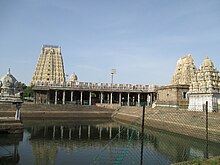
Back معبد ايكامباريسوارار ARZ Ekambareswarar Spanish Ekambareswarar tenplua Basque एकाम्बरेश्वर मंदिर, कांचीपुरम Hindi ഏകാംബരേശ്വര ക്ഷേത്രം Malayalam Templul Ekambareswarar Romanian Tempulli Ekambaresvarar Albanian காஞ்சிபுரம் ஏகாம்பரநாதர் கோயில் Tamil ఏకాంబరేశ్వర దేవాలయం Tegulu اکامبیشور مندر Urdu
| Ekambareswarar Temple | |
|---|---|
Arulmigu Kanchi Ekambaranathar Thirukoil | |
 | |
| Religion | |
| Affiliation | Hinduism |
| Deity | Ekambaranathar (Shiva) |
| Location | |
| Location | Kanchipuram |
| State | Tamil Nadu |
| Country | India |
| Geographic coordinates | 12°50′51″N 79°42′00″E / 12.84750°N 79.70000°E |
| Architecture | |
| Type | Dravidian architecture |
| Creator | Pallava, Chola kings |
Ekambareswarar Temple (Ekambaranathar Temple) is a Hindu temple dedicated to the god Shiva, located in the town of Kanchipuram in Tamil Nadu, India.[1] It is significant to the Hindu sect of Saivism as one of the temples associated with the five elements, the Pancha Bhoota Stalas, and specifically the element of earth, or Prithvi. Shiva is worshiped as Ekambareswarar or Ekambaranathar or Rajlingeswaram, and is represented by the lingam as Prithvi lingam. His consort Parvati is depicted as Elavarkuzhali.
The presiding deity is revered in the 7th century Tamil Saiva canonical work, the Tevaram, written by Tamil saint poets known as the nayanars and classified as Paadal Petra Sthalam.
The temple complex covers 10 hectares (25 acres), and is one of the largest in India. It houses four gateway towers known as gopurams. The tallest is the southern tower, with 11 stories and a height of 58.5216 m (192 ft), making it one of the tallest temple towers in India. The temple has numerous shrines, with those of Ekambareswarar and the Vishnu shrine - Nilathingal Thundam Perumal (a Divyadesam)[2] being the most prominent. The temple complex houses many halls; the most notable is the thousand-pillared hall built during the Vijayanagar period.
The temple has six daily rituals at various times from 3:30~4:00 a.m. to 10 p.m., and twelve yearly festivals on its calendar. Panguni Uthiram festival celebrated for thirteen days during the Tamil month of Panguni (March - April) is the most prominent festival of the temple and the town.[3]
The present masonry structure was built during the Chola dynasty in the 9th century, while later expansions are attributed to Vijayanagar rulers. The temple is maintained and administered by the Hindu Religious and Charitable Endowments Department of the Government of Tamil Nadu. The temple is the largest and one of the most prominent tourist attractions in the city.[4]
- ^ Let's Go India and Nepal, 8th Ed. Let's Go Publications. p. 585.
- ^ Sajnani 2001, pp. 305
- ^ Panguni Uthiram at Lord Ekambaranathar Temple [1]
- ^ Gopal 1990, p. 177
© MMXXIII Rich X Search. We shall prevail. All rights reserved. Rich X Search

